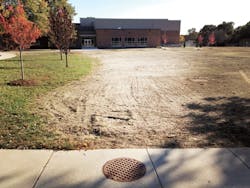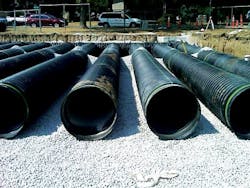About the author: Steve Cooper is a writer for SCA Communications. Cooper can be reached at [email protected].
A total of 1,440 ln ft of HDPE pipe was used for the underground system.
To meet the storm water management requirements for a new addition to the Indian Woods Middle School in Overland Park, Kan., just one underground detention system was constructed.
The original design called for three storm water treatment units to meet the local ordinance. This was because the 16,000-sq-ft proposed building addition, along with sidewalks, exceeded the 5,000-sq-ft threshold outlined in the Overland Park Municipal Code. The system also had to meet regional environmental requirements.
Additionally, several area homes were identified in the Indian Creek Watershed Study as being subject to flooding. The municipal code requires storm water detention facilities be constructed for projects that result in an increase in peak discharge from the site whenever downstream homes or habitable buildings are flooded in a 1% or larger frequent storm, or when the homes and buildings would be flooded as a result of future development; or whenever streets are subjected to flooding in excess of the city engineer’s standards.
Necessary Improvements
Indian Woods Middle School is part of the Shawnee Mission School District and serves approximately 624 students in seventh and eighth grades. The expansion was done because the closing of another middle school, led to an increase in Indian Woods’ enrollment. Improvements included four new classrooms, a library and an auxiliary physical fitness area.
The final storm water management system measures 130 ft wide by 154 ft long, with 12 rows of 30-in.-diameter corrugated high-density polyethylene (HDPE) pipe from Advanced Drainage Systems Inc. (ADS). A total of 1,440 ln ft of the N-12 watertight HDPE pipe that meets ASTM Standard F2306 was used, along with 103 ft of watertight manifolds. The complete system is designed to hold 7,600 cu ft of storm water—60,800 gal—at a rate of 1.37 cu ft per second. The detained storm water is released into the existing storm sewer system at a controlled rate to minimize the additional storm water burden imposed by the gymnasium addition, impervious roof and sidewalk areas.
The final underground storm water management system measures 130 ft wide by 154 ft long, with 12 rows of 30-in. diameter corrugated HDPE pipe.
System Specifics
“This entire system provides a technological advantage to hold water and trap debris,” said Jim Clemans, vice president of allied products for ADS. “All components are designed and manufactured to provide a long-life, low-maintenance and highly effective storm water management solution.”
Storm water enters an ADS Flexstorm inlet filter with a Nyloplast inline drain basin. It then exits through a submerged outlet chute located opposite to the direction of the rotating flow. Enhanced vortex separation is provided by forcing the rotating flow within the vessel to follow the longest path possible rather than directly from inlet to outlet.
Higher flows bypass the treatment chamber to prevent turbulence and washout of captured pollutants. An integral bypass chute conveys infrequent peak flows directly to the outlet chute, eliminating the expense of external bypass control structures. Floatables are diverted from the bypass chute into the treatment chamber.
About the Author
Steve Cooper
Steve Cooper is a writer for SCA Communications. Cooper can be reached at [email protected].

